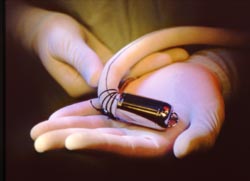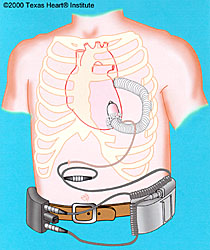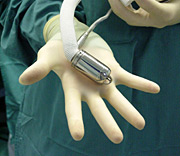Jarvik Heart, Inc. and the Texas Heart Institute began developing the Jarvik 2000 Heart in 1988. About the size of a "C" battery, the device is a valveless, electrically powered axial flow pump that fits directly into the left ventricle and continuously pushes oxygen-rich blood throughout the body. In April 2000, THI was granted permission by the Food and Drug Administration to evaluate the Jarvik 2000 Heart as a bridge to transplantation in five patients. In October 2000, the FDA gave permission to extend the study. Patients have been sustained for more than 400 days with this device.
 The Pump
The Pump
The Jarvik 2000 Heart is an axial flow blood pump that uses electrical power to rotate a vaned impeller—its only moving part. The device is 2.5 cm wide, 5.5 cm long, and weighs 85 grams. The impeller is a neodymium-iron-boron magnet, which is housed inside a welded titanium shell. The impeller is supported by ceramic bearings. A small cable, which exits the body through the abdominal wall, delivers power to the impeller. All of the blood-contacting surfaces are made of highly polished titanium. The normal operating range for the control system is 8,000 to 12,000 revolutions per minute, which will generate an average pump flow rate of 5 liters per minute.
 The Control System
The Control System
The pump speed is controlled by the FlowMaker, an analog system controller. The pump speed can be manually adjusted from 8,000 to 12,000 rpm in increments of 1000. The control unit monitors the pump function and the remaining power in the batteries. Audible and visual alerts notify the user of any problems.
For more information, you can read an article entitled, "Research and Development of an Implantable, Axial-Flow Left Ventricular Assist Device: The Jarvik 2000 Heart," which appears in Volume 71 (2001) of the journal Annals of Thoracic Surgery (pp. S125-S132).



